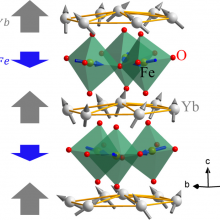Multiferroicity in hexagonal rare earth ferrites
Multiferroic materials exhibit multiple ferroic orders simultaneously, which enables novel application in information storage and processing, as well as in sensor and actuators. Hexagonal rare earth ferrites stand out in multiferroic materials due to the coexisting spontaneous magnetic and electric dipole moment, meaning they are both ferromagnetic and ferroelectric. Importantly, both the magnetic and ferroelectric order hinges on the structural distortions in the layered structure. The ferroelectricity is induced by the structural distortion below about 1000 K with sizable electric polarization. Below about 100 K, the antiferromagnetic order, which is topologically forbidden in undistorted structure, develops in a non-collinear fashion, together with the ferromagnetism originated from the canted moments. In this talk, I will discuss our recent work on the coupling between the crystal structure and the multiferroicity in hexagonal rare earth ferrites, and the structural tuning of the multiferroic properties.
Reference
Kishan Sinha, et al. "Tuning the Neel Temperature of Hexagonal Ferrites by Structural Distortion", Phys. Rev. Lett. 121, 237203 (2018).
Kishan Sinha, et al. "Effects of biaxial strain on the improper multiferroicity in h-LuFeO3 films studied using the restrained thermal expansion method." Phys. Rev. B. 95, 094110 (2017).
Shi Cao, et al. “On the structural origin of the single-ion magnetic anisotropy in LuFeO3” J. Phys. Cond. Matt. 28, 56001 (2016).
Bio
Dr. Xiaoshan Xu has obtained his Ph.D. degree from Georgia Institute of Technology in Physics with minors in Computer Science and his B.A. and M.S. degrees from Nanjing University in Physics. He has worked as a postdoctoral research associate in the University of Tennessee and a staff member in the Oak Ridge National Lab. He is a recipient of the Eugene Wigner Fellowship in the Oak Ridge National Lab, Faculty Early Career Development Award from the National Science Foundation, and the Early Career Award from the Department of Energy. Dr. Xu joined University of Nebraska-Lincoln since 2013 as an assistant professor in physics and faculty associate in Nebraska Center for Materials and Nanoscience.

